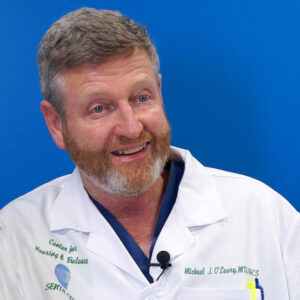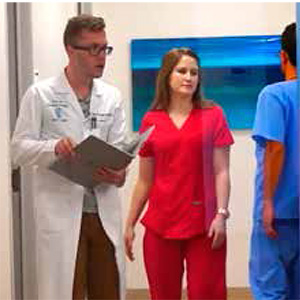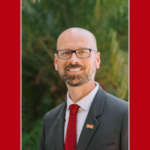
Dr. Michael O’Leary, founder of Senta Clinic
San Diego is home to a world-renowned destination for disorders of the ears, head, and neck. Founded in 2004, Senta Clinic specializes in the diagnosis and treatment of diseases of the brain, spine, and skull base. Additionally, the ear clinic works exclusively with students of the Clinical Medical Assistant Professional Certificate program at SDSU’s College of Extended Studies.
“For the last two years, once I discovered them, my only externship hires have come from that program,” said Dr. Michael O’Leary, who made U.S. News & World Report’s “2014 Top Doctors” list, along with colleagues Dr. Brian Weeks, Dr. Perry Mansfield, and Dr. Sanjay Ghosh. “SDSU students are, to a person, energetic, bright people going places. The high caliber of these externs, most of whom are on their way to other advanced degrees such as nurse practitioner and physician assistant, reflect the high-caliber individual working on our neurotology team.”
Dr. O’Leary answered a few questions about SDSU’s Clinical Medical Assistant program and the externship through Senta Clinic.
What’s your background in medicine?
The Navy provided my medical education at Georgetown and although I only owed them three years, I stayed for 20 because of my highly specialized ear team at Navy Hospital Balboa [officially called Navy Medical Center San Diego]. I wasn’t worried about anyone’s financial ability to see a doctor — that was a gift to me as I crafted my care in medicine. The program was very high end with very good doctors. We were mostly fellowship trained, and often at world-famous academic centers. Coming to private practice and holding on to that high standard was a challenge that we’ve accomplished at Senta Clinic. The SDSU program is a natural fit since as long as you stay connected to the pure “patient care” focus of health care, you’ll love what you do!

SDSU student Mackenna Wilcoxson and Senta employees in discussion.
What type of student is best suited for the Clinical Medical Assistant program?
The best students for this program are those who are on their way to something higher in health care. Physician assistant is a huge growth area; we really love people on track for that. In order to become a physician assistant, you need several thousand hours of clinical exposure. So a great way to get that is through medical assist, especially if it’s closely connected to the doctor as we do here at Senta. We have a very “horizontal structure” with minimal bureaucratic management layers, which ensures students get extensive direct time with the doctor.
What’s the duration of an externship and what does a typical day look like for students?
An extern usually spends a 40-hour work week during his/her four weeks at Senta Clinic, although this and the days worked are highly flexible. And there is no typical day. Some days are very busy with acute patients with new problems, whereas other days involve routine patients who’ve been cured of their acute problems and are now in preventive care. Some days are involved in the business of the practice while the surgeon is operating. Every day brings a new experience.
How does the fast-track aspect of the program — the 160-hour externship — benefit students?
In other programs that I’ve seen, I think too much time is spent in technical skillset training, i.e. venipuncture, EKGs, urinalysis, etc. They spend lots of time teaching students how to draw blood — 90 percent of whom will never draw another bit of blood in their entire career. And what you end up doing is putting people in a classroom setting instead of letting them experience health care. In the experience of health care is the information of whether you’re the right fit or not. If you don’t feel the positive patient feedback and really a joy of living and a desire to go further, you should probably choose a different career. This is a tough career. If you connect with patients and say at the end of your day, “I love what I did today, I can’t wait to be at work tomorrow,” then this is the right career for you. And I really think the fast-track program gives you that taste early before you make the wrong decision.
For people that are really aimed at being health-care providers and understanding the care component of that, they’re going to love this program. They get a look at real medicine, which is a fast-paced, high-intensity thing which still keeps the patient as the main focus and priority. People are sick so there’s a little bit of urgency. We’re not an ER — we’re doing outpatient care and we’re doing a very high level, so students see the benefits of people coming in sick and after a few visits or so, getting better. So if you see my assistants, they’re going to know the patient’s first name when they come in, and they’re very attentive to all the things that make this a bigger experience for the patient, meaning we’re really there to serve them.
It sounds like customer service is a high priority at Senta Clinic.
In health care right now we say “customer care.” Some doctors say “I don’t have customers, I have patients.” What I say to the doctor is “Well then at a minimum, your care should be at least at customer level.” If patient care is at a higher level, we should be doing better than general customer service. A great example in my clinic is that patients rarely spend time in the waiting room. We greet them and they come straight into an exam room and we’re seeing them very shortly. They usually don’t have to check out since we’ve done much of that work during the course of their visit. So we’ve eliminated two big parts of the traditional medical process that add no value to the whole interaction. I always say, “If you want to read some of our books, feel free to go in the waiting room after the visit.” (Laughs) None of them want to do that.
Where did the idea come from to not have a waiting room?
This “continuous process improvement” focus came from my Navy career post-graduate training. During externship at Senta Clinic, the extern is exposed to several modern quality trends aimed at both the personal and team level including Covey’s seven habits, principle-centered leadership, Deming principles of continuous quality improvement combined with elements of Six Sigma training, and emotional IQ.
You achieved Eagle Scout status in 1969 and won a Navy Battle Effectiveness Award in 1981 and 1982. You started early on a course of service and excellence. To what do you attribute that?
Much of my dedication and leadership interest is a product of mentorship by my dad, Denis J. O’Leary, a chest specialist who graduated from medical school in Ireland and did his postgraduate training in Canada and then New York. He was a patient-oriented physician before it was “cool” and I greatly admired his sense of service and tireless dedication. I saw directly the benefits that come back from patients on a healthy track.
SDSU’s College of Extended Studies offers five Professional Certificate programs in Health Care: Clinical Medical Assistant, Pharmacy Technician, EKG Technician, Nutrition for Optimal Health and Wellness (online), and Nutrition for Optimal Health, Wellness, and Sports (online). For more information, visit neverstoplearning.net/healthcare




